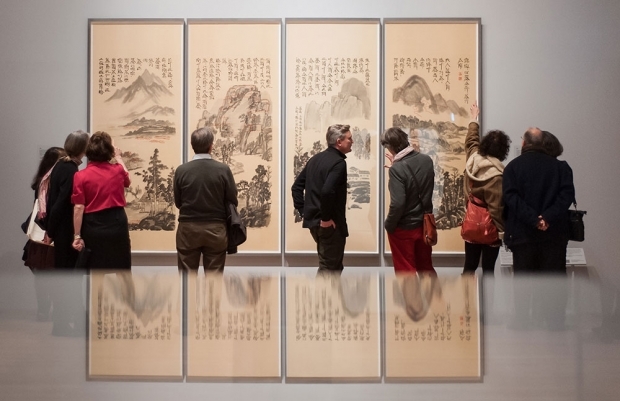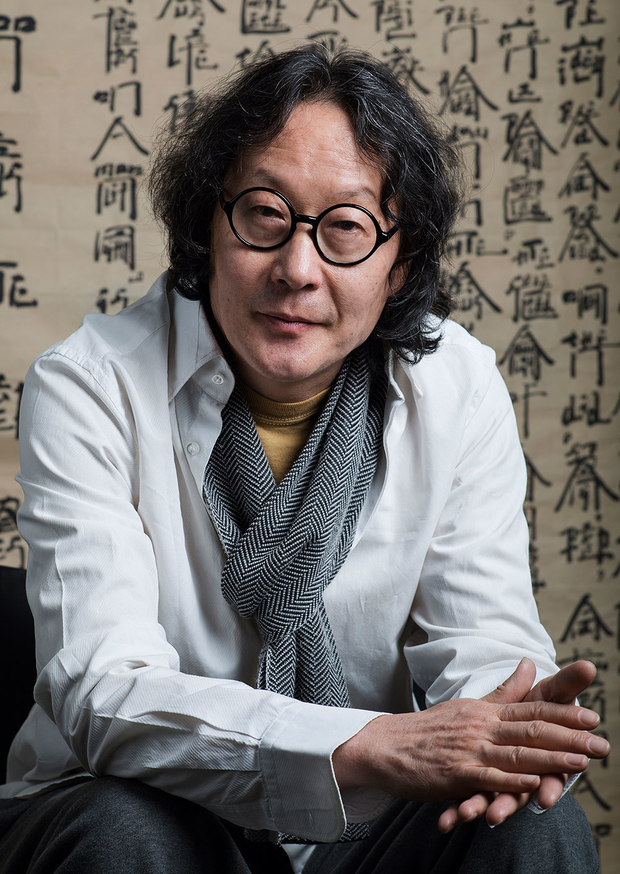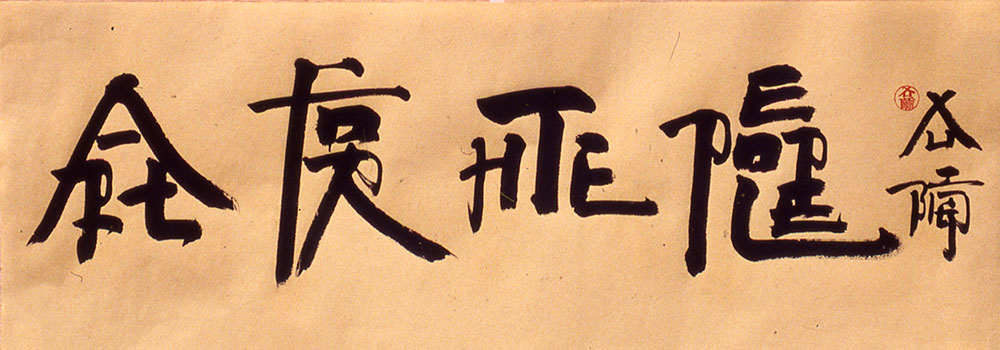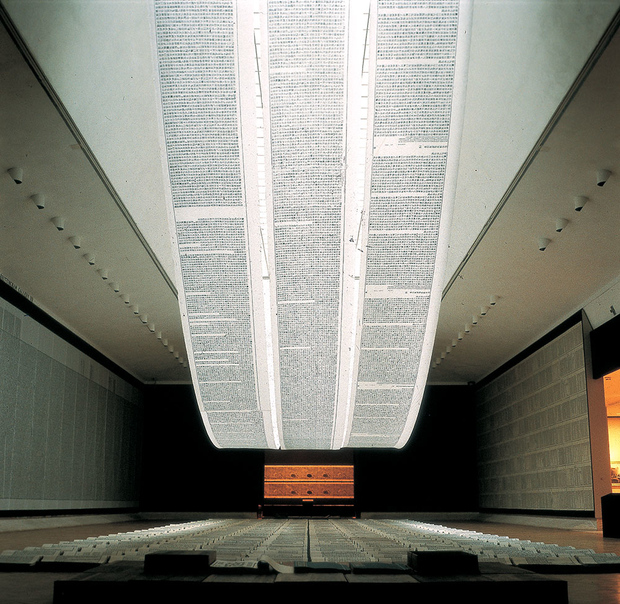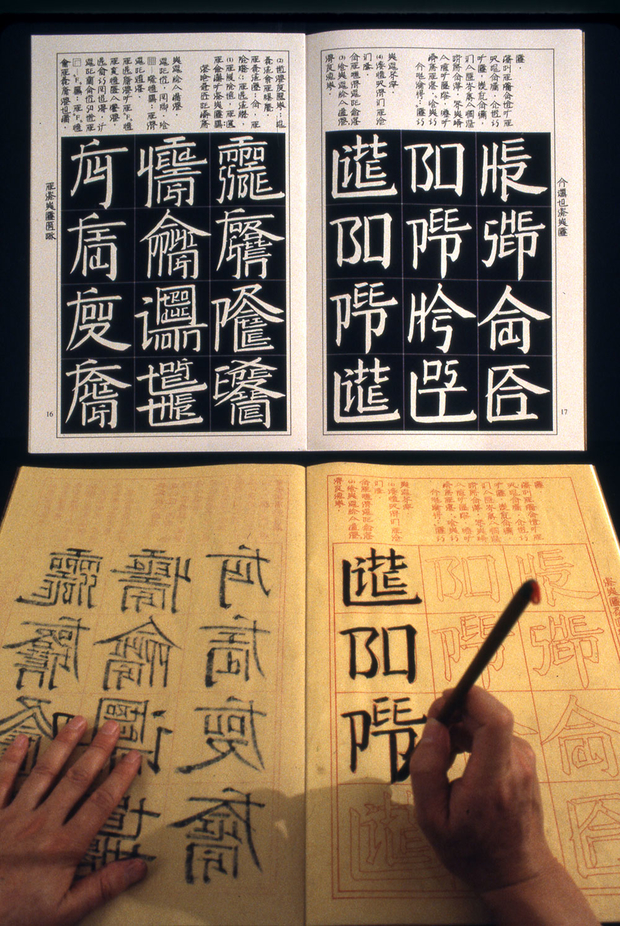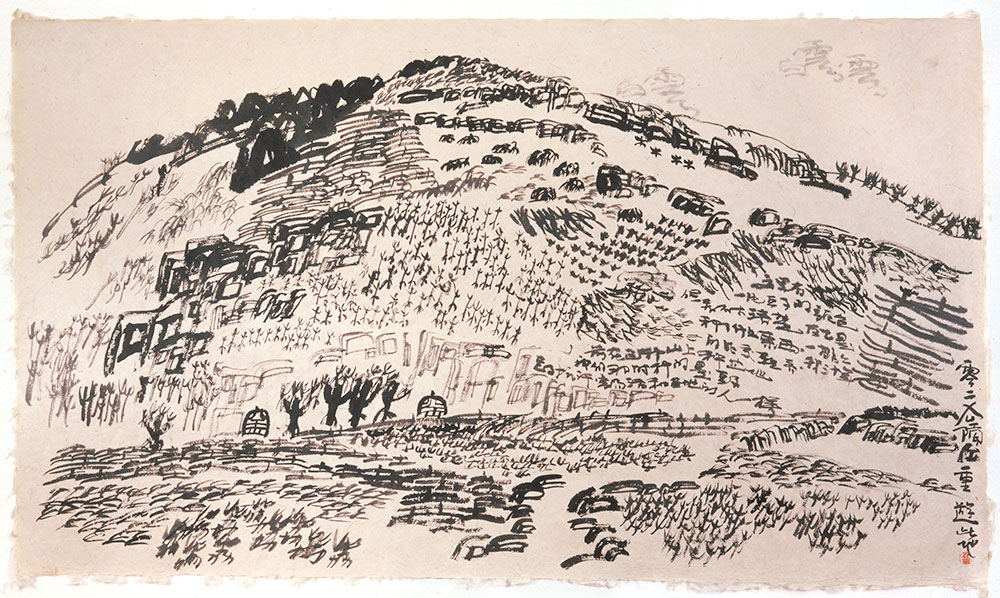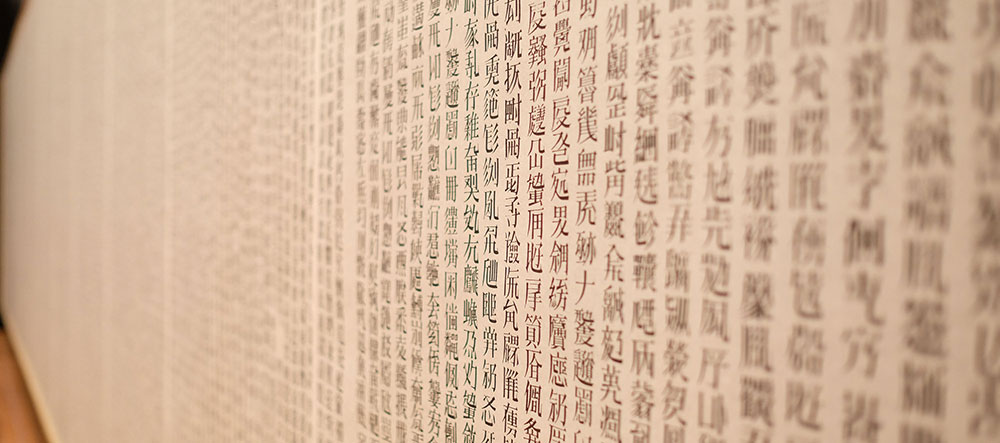Way back when, let’s say in 2012, the city of Miami and the country of China rarely mixed in sentences. Since then, connections between the Far East and the northernmost part of Latin America have become more and more frequent. Three years ago, a Hong Kong group started constructing an entire city center in downtown Miami. Last year, a large exhibition of contemporary Chinese art opened at the Rubell Family Collection. Its opening seemed to coincide with a loud crash from close by. That was the sound of one of Ai Weiwei’s painted vases intentionally dropped to the floor by a local artist unhappy at being passed over by the Perez Art Museum of Miami. The stunning newly-opened Herzog and de Meuron museum had been gambling that the infamous Chinese artist (who has destroyed his own share of precious vases) would draw a crowd. The smashed vase did the trick.
Now Miami turns to the prodigiously talented Xu Bing, Ai Weiwei’s rival and old friend from the 1990 post-Tiananmen exodus to New York. These days, in the United States at least, Xu sits in Ai’s shade. It’s worth remembering that for many years their relative ranks were reversed. When Xu Bing was accepting a MacArthur “Genius Grant” in 1999, Ai Weiwei hadn’t even been included in Asia Society’s groundbreaking exhibition of contemporary Chinese art, “Inside Out.”
The Xu Bing exhibition at the The Patricia and Phillip Frost Art Museum, which runs through May 24, is both grand and highly selective. It focuses on a handful of Xu’s works, including his “Book from the Sky.” At first glance, Xu Bing seems to be the opposite of Ai Weiwei. While Ai is seen as a political provocateur, Xu Bing expresses no interest in politics at all. While Ai has been jailed, beaten, and interrogated, Xu was invited back to China in 2008 to become Vice President of the Central Academy of Fine Arts. And yet, curiously, Xu Bing’s work can seem as deeply confrontational as Ai Weiwei’s. Perhaps only in China could an avowedly apolitical artist produce such political art.
Xu Bing was born in 1955. His generation would lurch helplessly into the terror of the Cultural Revolution. When he was 11 years old, the “Smash the Four Olds” campaign was unleashed against traditional customs, habits, culture, and thinking. Mao had already shackled contemporary art to the ideals of “Socialist Realism,” but suddenly all signs of tradition were supposed to be erased. Memoirs of the time abound with shattered statues, ripped scrolls, and classical music LP’s snapped in half as the nation’s youth were encouraged to erase the past. Under his father’s tutelage Xu Bing was already fascinated by painting and printmaking, but what good was a creative bent, not to mention artistic talent, when only allegiance to the leadership was required?
His father was a professor of history at Peking University, the epicenter of the Cultural Revolution. It was where Mao himself had written the famous dazibao, or Big Character Poster, “Bombard the Headquarters.” It was also where Xu witnessed his father’s public humiliation. After his father was fired and jailed, Xu Bing, alongside tens of thousands of other Beijing youth, was “sent down to the countryside” for reeducation.
Even in the countryside his talents were noticed. In his own words, he contributed “blindly” to Mao thought, helping to crank out Big Character Posters. Millions were produced in every village, town, and city in China. Some were propaganda, some were protests, and some were denunciations. In Beijing, they were posted everywhere alongside portraits of Mao, covering whole buildings, papering over the past. Xu would later come to the conclusion that Mao and Andy Warhol shared much in common. “If you had the experience of the Culture Revolution in China,” he once told The Brooklyn Rail, “you can understand authentic pop culture.” Mao, Xu continued, “actually had a lot of avant-garde ideas.” The dazibao betrayed language. So few words were safe from judgment that those words seemed to lose their meaning as they were repeated endlessly across the nation. The politically suspect, such as Xu Bing’s father, were subjected to hour after hour after hour of interviews. Few could stay within the sanctioned language of the Cultural Revolution. As people were forced to write confessions and self-criticisms, they slipped outside the approved lexicon. Those words and phrases would then be twisted against them.
How strange it must have been to walk down a familiar street with walls now covered in dazibao and seeing the same safe sentiments repeated again and again. The words didn’t mean anything other than a signal that the writer was committed to the cause, or at least eager to avoid being singled out. When you first see Xu Bing’s extraordinary “Book from the Sky,” you can’t help but pause and think of a teenage Xu’s memories of dazibao. There are words sweeping down from above on banners, rising from the floor in stacks of books, hemming you in between completely covered walls. It’s ethereal and claustrophobic. If you don’t read Chinese, you stare at the waves of pictograms and wonder what they mean. If you do read, you soon realize that they mean nothing at all, at least not on their own. The script consists of around 4,000 invented characters, roughly the number that a Chinese schoolchild learns before being considered literate.
“Book from the Sky” is simultaneously playful and solemn. If you’re lucky enough to see it when there are few others around, you get the sense that you’ve tiptoed into a temple. The human brain wants to understand the surrounding language, to make sense of the characters even after you’re told there’s no sense to be found. Your eyes wander from character to character. You look for familiarity, for repetition. The characters seem to have tops, bottoms, sides—just like real Chinese characters—and yet they mean nothing.
The New York gallerist Ethan Cohen, who introduced both Xu Bing and Ai Weiwei to the United States back in the 1980s, calls the piece “an intelligent response to art making in a culture where artists aren’t allowed to speak freely.” Did Xu Bing intend to critique the government? Was this a direct commentary on the constraints of language during the Cultural Revolution? Or was his a grander sentiment on language—life’s safer when words have no meaning?
Personally, I found it impossible not to think of a teenage Xu Bing making Big Character Posters at a time when dogma made language both empty and dangerous, but “Book from the Sky” also reaches back far beyond Mao. The piece asks one of the oldest questions in China posed by Confucius: You can see the heavens (made of words draping down the gallery), you are standing on the earth (the handbound books on the floor), you can even see the edges of the known universe (the museum walls are covered in script), but where do you, as a human being, belong? You’re supposed to find a balance. Is that even possible without a language? Can you find peace within chaos?
Culture
11.21.12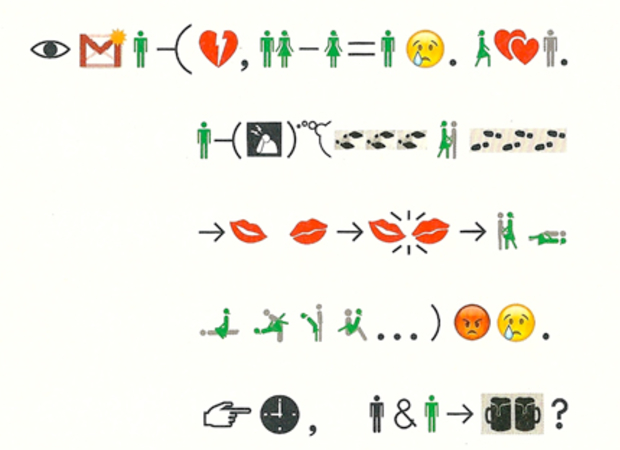
A New Tower of Babel
The fact that Xu Bing’s words are hanging in Miami seems particularly apt. It’s a city that was on the frontline of the “English Only” movement as a reaction to a sudden influx of Cuban refugees in 1980. In Miami, sentences frequently begin and end in different languages. You get the feeling that might lead to a particular appreciation of Xu Bing’s “Square Word Calligraphy.” The far room of the exhibition is presented as a classroom, with brush-stands, ink, and brushes that invite the visitor to trace Chinese characters. Only, on closer inspection, they’re not Chinese characters at all. They’re English words, the letters sitting on top of one another so that from a distance you presume they’re pictograms. With a little practice, they’re easy to read, easy to create.
Is one language co-opting another? Is English masquerading as Chinese or is Chinese beginning to shape English? Either way, the piece makes you reconsider both languages. It makes you think of the creation of languages. Why did one people separate words letter by letter from a limited alphabet and why did another people choose pictograms? Xu Bing is still adding to this lexicon over twenty years after creating it. Languages do not sit still and neither do great artists.
Across the hall, just meters from “Book from the Sky,” is “Book from the Ground.” If “Book from the Sky” is designed to engage and then confuse, “Book from the Ground” is all about an easy universality. If you don’t believe me, bring an eight-year-old with you. There are two computers. As you type words into them, they’re translated into corresponding icons that appear on a large screen before you. The list of icons is ever-growing, tallied and expanded by Xu Bing on his travels. Again, you’re interacting, amazed at how quickly your brain is registering new patterns of language and building full sentences. As an artwork it’s not as fascinating as “Book from the Sky” because it succeeds too easily. That’s a compliment to its creator.
As you walk around the exhibition, it dawns on you that you’re in a monochromatic world. Xu Bing is never far from Chinese artistic traditions. The first and last pieces you’ll encounter are “Suzhou Landscripts” and “Mustard Seed Garden Landscape Scroll” where, once again, Xu Bing is playing in the space between tradition and modernity. From a distance, you’ll see the familiar traditional black and white landscapes. Woods, rivers, houses amidst trees under mountains. But look closely and the trees are made up of the pictograms for trees, you know the building by the river is a distillery because it consists of the characters for liquor or wine and factory.
High art was always black and white in Imperial China. Color was a needless distraction. Imitation wasn’t frowned upon, it was embraced. The room that contains his “Suzhou Landscripts” is typical Xu Bing. It embraces tradition and then undermines it. It copies only to subvert.
In an email to me, Xu wrote that not so long ago ideas as simple as “harmony with nature” were considered reactionary in China. To even talk about “nature” was considered outdated and weak during such an era of industrialization. But he rescued those ideas in his art and brought them quietly to the fore. “Ancient ideas,” he wrote, can become “avant garde again.” Xu wasn’t reflecting the political present, but projecting change. If that’s not political, I don’t know what is.
As with Chinese calligraphy, the landscapes were supposed to serve a double purpose. Realism was secondary. First, the landscape was supposed to capture both the outer and inner essence of its subject. Then, if the artist was good, the landscape would also reveal the artist’s spirit. In the Frost Museum, Xu Bing is very much on display.




